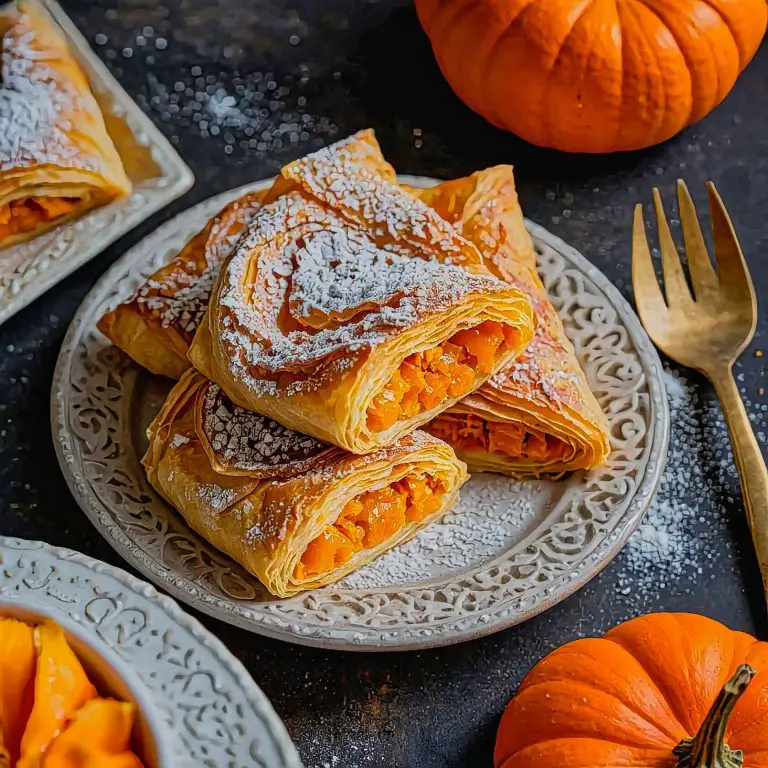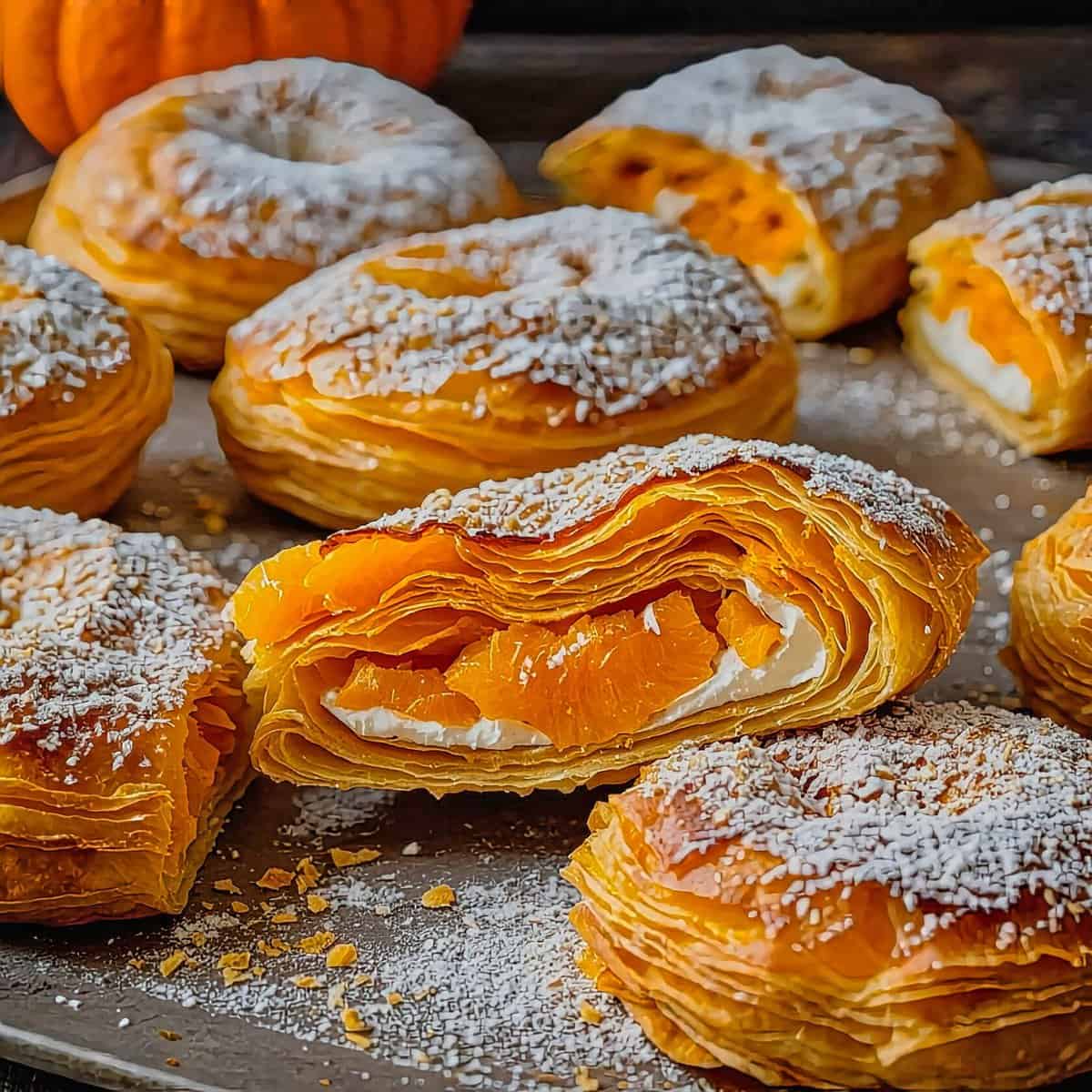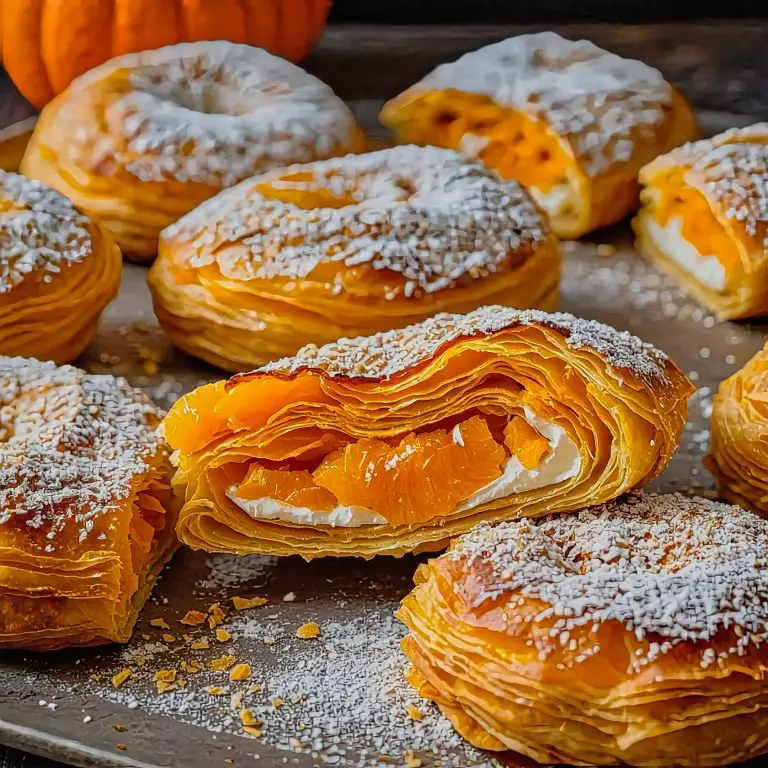Bulgarian Tikvenik Recipe: Tikvenik is a beloved Bulgarian pastry that showcases the rich flavors of pumpkin wrapped in layers of flaky phyllo dough. This delightful pumpkin strudel not only highlights the warmth of autumn but also brings a touch of tradition to any table.
Making Tikvenik is an enjoyable way to experience Bulgarian culture and share delicious food with loved ones.
As we gathered recipes during our travels, Tikvenik stood out for its simplicity and wonderful taste. The blend of sweet pumpkin, sugar, and warm spices creates a filling that is both comforting and satisfying.
In this blog post, we will guide you through the steps to create your own Tikvenik, ensuring that you can capture the essence of this classic Bulgarian dish in your kitchen.
Join us as we explore the history and techniques behind this traditional pumpkin strudel recipe. With each bite, you’ll appreciate the effort put into this lovely pastry and the joy it brings to family gatherings and celebrations alike.
Why You’ll Love This Bulgarian Tikvenik Recipe
We adore the Bulgarian Tikvenik for several reasons. This delightful pastry combines the sweetness of pumpkin with warm spices like cinnamon. It’s a great way to enjoy a unique dessert that’s full of flavor.
This traditional Bulgarian pastry, often known as bundevara, uses flaky phyllo dough that adds a satisfying crunch. The filling of grated pumpkin, sugar, and walnuts creates a wonderful contrast in texture.
Here are a few highlights of this recipe:
- Simple Ingredients: You’ll find common ingredients in many kitchens.
- Customizable Flavors: Adjust the sweetness or spice levels according to your taste.
- Perfect for Any Season: While it’s especially popular in the fall and winter, Tikvenik can be enjoyed year-round.
Making Tikvenik is a fun activity for families. We love sharing the process with friends, as it’s easy to prepare and brings everyone together.
Plus, this sweet treat can be served warm or cold, making it a versatile option for gatherings. Whether you savor it with a cup of coffee or serve it at a festive event, it never disappoints.
Join us in trying this charming recipe, and experience why Tikvenik is beloved in Bulgaria and beyond!
What Makes This Bulgarian Tikvenik Recipe Special
We find that Bulgarian Tikvenik stands out for several reasons. This dessert offers a delicious combination of flavors and textures that make it a delightful treat at any time of day.
Key Features:
- Unique Texture: The crisp phyllo pastry envelops a soft, sweet pumpkin filling. This contrast provides an enjoyable eating experience.
- Flavorful Ingredients: The pumpkin filling is often gently spiced with cinnamon, enhancing its sweetness. This warm spice makes Tikvenik a comforting choice, especially in cooler months.
- Cultural Heritage: Tikvenik reflects Bulgarian culinary traditions. Many families pass down their recipes, adding personal touches over generations.
- Versatile Snack: It can be enjoyed warm as a dessert or at room temperature as an afternoon snack. Tikvenik’s versatility makes it perfect for gatherings or quiet afternoons.
Making It Personal:
We love how this recipe allows for customization. From adjusting sweetness to adding nuts, each batch can feel unique. Making Tikvenik can be a special moment to share with loved ones.
Enjoying this flavorful pumpkin pie brings us closer to Bulgarian culture. We appreciate not just the taste, but also the story behind each bite.
Cooking Equipment Needed
To make delicious Tikvenik, we need a few essential pieces of equipment.
1. Baking Tray
A sturdy baking tray is crucial for holding the assembled Tikvenik. We recommend using one with a non-stick surface or lining it with parchment paper.
2. Mixing Bowls
We need mixing bowls for combining ingredients. A large bowl is ideal for the pumpkin filling and a smaller one for any spices or sugar.
3. Pot for Boiling Pumpkin
We can use a pot to boil or steam the pumpkin until it is tender. This will make it easy to mash or puree.
4. Fork or Masher
A fork or potato masher helps us to fully puree the cooked pumpkin. Smooth filling is key for a flavorful Tikvenik.
5. Rolling Pin
If we decide to make our own phyllo dough, a rolling pin is necessary for rolling out the dough sheets. Store-bought phyllo can be used for convenience.
6. Brush for Butter
A pastry brush is useful for applying melted butter between the layers of phyllo pastry. This keeps the Tikvenik flaky and delicious.
7. Sharp Knife
We will need a sharp knife for cutting the pastry into individual pieces after it is baked. This helps in serving and presentation.
With this equipment ready, we can enjoy the process of making Tikvenik!
Cooking Instructions
To make Bulgarian Tikvenik, we will use a few key ingredients. Here’s how we can prepare this delicious pumpkin pastry.
Steps:
- Prep the Pumpkin:
- If using fresh pumpkin, peel and grate it into fine shreds.
- Cook the grated pumpkin in a pan with a little oil until soft.
- Mix the Filling:
- In a bowl, combine the cooked pumpkin, sugar, ground cinnamon, ground walnuts, and raisins (if desired).
- Layer the Phyllo:
- Take one sheet of phyllo dough and brush it with melted butter.
- Place another sheet on top and repeat until you have about 4–5 layers.
- Add the Filling:
- Spread the pumpkin filling evenly across the phyllo layers.
- Roll It Up:
- Gently roll the phyllo with the filling into a log shape.
- Place the rolled Tikvenik on a baking sheet.
- Bake:
- Brush the top with more melted butter and sprinkle with brown sugar.
- Bake in a preheated oven at 375°F (190°C) for about 20-30 minutes until golden brown.
This Tikvenik is a delightful treat for any occasion. Enjoy!
Cooking Tips
When making Tikvenik, we recommend using fresh pumpkin for a better flavor. If fresh pumpkin isn’t available, canned pumpkin will work in a pinch.
Preparation: Grate the pumpkin finely to ensure it cooks evenly. We often let it sit for a few minutes after grating to release extra moisture.
Dough Selection: For a traditional touch, use thicker dough sheets found in Bulgarian stores. If unavailable, feel free to substitute with filo pastry, which is also effective.
Sweetness Adjustment: If your pumpkin is not sweet enough, we suggest adding around 7 ounces of sugar to the filling. Always taste as you go to achieve your preferred sweetness.
Layering: Brush each layer of dough with oil or melted butter. This helps to achieve a crispy texture after baking. It’s essential for a flaky and delicious result.
Baking: Bake until the top is golden brown. This usually takes about 20 to 25 minutes at 350°F (175°C). Watch closely to prevent burning.
Finishing Touch: After removing Tikvenik from the oven, dust it with powdered sugar for a nice presentation. This adds a hint of sweetness that complements the pumpkin.
Ingredients For the Bulgarian Tikvenik Recipe
Filling
Pumpkin
Butter
Sugar
Cinnamon
Walnuts
Pastry
Butter
Filo Pastry
Sugarr
Cooking Instructions For the Bulgarian Tikvenik Recipe
Pumpkin Pastry Coil Recipe
Preheat and Prepare the Skillet
Preheat the oven to 350°F (180°C).
Lightly butter a small skillet or frying pan (8in/20cm preferred, 7in/18cm also works).
Prepare the Pumpkin Filling
Peel and deseed the pumpkin, then coarsely grate it.
Melt butter in a large skillet over medium heat.
Add the grated pumpkin and cook for 1–2 minutes to soften.
Stir in the sugar and cinnamon, cooking for another 1–2 minutes, stirring occasionally to help evaporate excess moisture while maintaining texture.
Remove from heat and allow to cool slightly.
Prepare the Pastry
Melt butter for the pastry using a microwave or over low heat in a small pan.
Lay one sheet of pastry on a clean, dry surface and brush it with butter.
Place a second sheet of pastry on top, aligning the edges as best as possible.
Assemble the Rolls
Divide the pumpkin filling and walnuts into two equal portions.
Spread one portion of the pumpkin filling along one long edge of the pastry.
Sprinkle half of the walnuts next to or on top of the pumpkin filling.
Lightly brush the uncovered part of the pastry with butter.
Roll and Coil
Carefully roll the pastry from the edge near the filling to create a long log. Avoid rolling too tightly—some space makes coiling easier.
Pick up the roll and coil it inside the buttered skillet.
Repeat the process with the remaining pastry and filling. When placing the second roll in the skillet, connect its end to the previous coil to form one continuous spiral.
Bake and Serve
Brush the top of the coiled pastry with butter.
Bake for approximately 40 minutes, until golden brown and crisp.
Remove from the oven and let cool for a couple of minutes.
Dust with powdered sugar (icing sugar) before serving.
Serve warm or at room temperature, sliced through the coils.

FAQ For the Bulgarian Tikvenik Recipe
Question: What is a Bulgarian Tikvenik recipe?
A: A Bulgarian Tikvenik recipe is a traditional Bulgarian pastry made with thin phyllo dough filled with grated pumpkin, sugar, cinnamon, and walnuts. It is rolled, baked until golden brown, and often dusted with powdered sugar.
Question: What ingredients are needed for a Bulgarian Tikvenik recipe?
A: A Bulgarian Tikvenik recipe typically includes phyllo dough, grated pumpkin, sugar, cinnamon, crushed walnuts, vegetable oil or butter, and sometimes vanilla or raisins for added sweetness.
Question: How do you make a Bulgarian Tikvenik recipe?
A: To make a Bulgarian Tikvenik recipe, spread a mixture of grated pumpkin, sugar, cinnamon, and walnuts over phyllo dough sheets. Roll them up, arrange in a baking tray, brush with oil or butter, and bake until crispy and golden brown.
Question: Can a Bulgarian Tikvenik recipe be made vegan?
A: Yes, a Bulgarian Tikvenik recipe can be made vegan by using plant-based phyllo dough and replacing butter with vegetable oil. The filling of pumpkin, sugar, cinnamon, and walnuts is naturally vegan.
Question: How should a Bulgarian Tikvenik recipe be served?
A: A Bulgarian Tikvenik recipe is best served warm or at room temperature, often dusted with powdered sugar. It pairs well with tea, coffee, or a light dessert wine.

Bulgarian Tikvenik Recipe
Ingredients
- 16 oz Pumpkin peeled and de-seeded
- 3 tbsp Butter
- 6 tbsp Sugar
- 2 tsp Cinnamon
- 4 tbsp Walnuts chopped
- 3 tbsp Butter
- 8 sheets Filo Pastry
- 1 tbsp Sugar icing sugar
Instructions
- Preheat and Prepare the Skillet
- Preheat the oven to 350°F (180°C).
- Lightly butter a small skillet or frying pan (8in/20cm preferred, 7in/18cm also works).
- Peel and deseed the pumpkin, then coarsely grate it.
- Melt butter in a large skillet over medium heat.
- Add the grated pumpkin and cook for 1–2 minutes to soften.
- Stir in the sugar and cinnamon, cooking for another 1–2 minutes, stirring occasionally to help evaporate excess moisture while maintaining texture.
- Remove from heat and allow to cool slightly.
- Melt butter for the pastry using a microwave or over low heat in a small pan.
- Lay one sheet of pastry on a clean, dry surface and brush it with butter.
- Place a second sheet of pastry on top, aligning the edges as best as possible.
- Divide the pumpkin filling and walnuts into two equal portions.
- Spread one portion of the pumpkin filling along one long edge of the pastry.
- Sprinkle half of the walnuts next to or on top of the pumpkin filling.
- Lightly brush the uncovered part of the pastry with butter.
- Carefully roll the pastry from the edge near the filling to create a long log. Avoid rolling too tightly—some space makes coiling easier.
- Pick up the roll and coil it inside the buttered skillet.
- Repeat the process with the remaining pastry and filling. When placing the second roll in the skillet, connect its end to the previous coil to form one continuous spiral.
- Brush the top of the coiled pastry with butter.
- Bake for approximately 40 minutes, until golden brown and crisp.
- Remove from the oven and let cool for a couple of minutes.
- Serve warm or at room temperature, sliced through the coils.




1 comment
I made Bulgarian Tikvenik for the first time, and it was delicious! The pastry was crisp, and the pumpkin filling was perfectly spiced. It was a wonderful balance of flavors, and it wasn’t too sweet. My guests were impressed with how light and flaky the pastry was, and they enjoyed the unique taste of the filling. This will definitely be a go-to recipe for future gatherings.